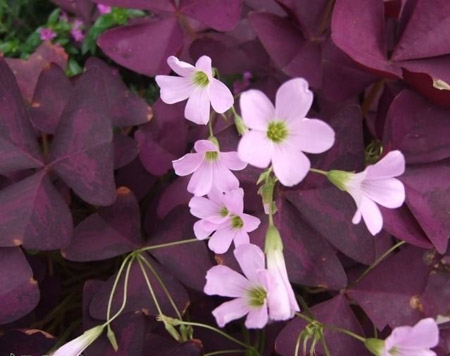Disease symptoms and treatment of wild slug in Oxalis purpurea
1. Morphological characteristics
Wild slugs belong to the family Limacidae of Stylommatophora, also known as slugs. The adult body is fusiform, 20-25mm long and 4-6mm wide; the body surface is smooth, without shell, dark gray, yellow-white or grayish red; two pairs of antennae, dark black, eyes at the end of the posterior antennae; the anterior end of the back of the body has an outer membrane, the edge is rolled up, there are obvious concentric growth lines, and the mucus is colorless; the egg is white and transparent, glial-oval, gathered into a lump in the oocyst; when the larvae are hatched, they are light brown and resemble adults.
two。 Occurrence regularity
Wild slugs occur for 1-2 generations every year, with adults and larvae overwintering under the wet soil of plant roots, and the damage is more serious in spring and autumn. The temperature of 11.5-18.5 ℃ and the soil water content of 20-30% are beneficial to its reproduction. Wild slugs lurk between the roots of Oxalis and soil cracks during the day and climb out of the ground at night, endangering the growth of Oxalis. It has a strong ability to tolerate hunger and can not eat or move under poor or poor food conditions. Wild slug likes dark and humid environment, especially in the corner of greenhouse in spring and the environment with high plant density and poor ventilation is the most harmful. The peak time of feeding activity is from evening to dawn the next day. In case of adverse environment, such as dryness and odor stimulation, the wild fish can quickly contract the abdominal foot in the shell and secrete mucus to form a liquid film outside the shell mouth to protect itself from the adverse environment. But there is a strong tendency towards sugar. Wild slugs are afraid of light and will die after 2-3 hours of strong sunlight.
3. Hazard characteristics
The wild herbivore has mixed food habits and likes to eat the leaves and petioles of Eleurotus angustifolia, forming irregular gaps, holes or dead seedlings. The damaged leaves were scraped and contaminated by feces, which lost their ornamental value. The body of a wild slug carries a variety of germs, and the wound caused by its bite becomes a passage for germs to invade, causing fungus infection and leaf decay.
4. Prevention and cure measures
Wild slug has a strong concealment, the body surface secretes a lot of mucus, the liquid is not easy to reach the insect body directly, the general insecticide is difficult to be effective, it is a difficult pest to treat.
① agricultural prevention and control:
Dig a good drainage ditch in the greenhouse, pay attention to drainage, lower the groundwater level, and remove weeds in time. Ploughing and weeding on a sunny day causes the eggs to die on their own when exposed to the soil surface. Sprinkle lime powder or plant ash on the edge of the purple leaf grass place in the open field to reduce humidity and create an environment that is not conducive to the movement of wild slugs, which will die of water loss when they climb over.
Chemical control of ②:
During the outbreak of wild slugs, they were sprayed with 100 times ammonium bicarbonate and 40% of slug water concentrate 100 times. Because the slug is not active during the day, the liquid is not easy to be sprayed on the wild mackerel, so the control effect is not ideal. Therefore, before chemical control, the ground in the greenhouse and flowerpots should be watered to increase the environmental humidity to facilitate slug activity and apply in the evening. In order to achieve a sustained and effective control effect, it is necessary to carry out 2-3 consecutive times of control. Making use of the aroma-seeking habit of wild slugs, snail enemies were used to prepare oil-withered powder or cornmeal poison baits containing 4% of the active ingredient, which were scattered on the ground between the gaps in flowerpots or at the edge of flowerpots in the evening. Chemical control experiments showed that the control effect was more than 85%.
The prevention and control of diseases and insect pests of Oxalis purpurea is a complex and comprehensive work. It should be based on agricultural activities, give priority to prevention, put an end to the sources of diseases and insect pests, and carry out comprehensive management combined with physical methods, chemicals and biological natural enemies. Follow the principle of "cure early, cure small, cure", eliminate diseases and insect pests in the initial stage of occurrence, and can not wait until sorrel is seriously damaged before treatment.
Symptoms and treatment of root rot of purple leaf sorrel 1. Symptoms of onset
Root rot harms the roots and bulbs of Oxalis purpurea. The damaged plants showed wilting under sunlight during the day and recovered from night to early morning. The initial symptoms were that the leaves of Oxalis purpurea showed a state similar to that of lack of fertilizer and loss of purple; the roots were wrinkled; the fibrous roots were less and yellowish brown; and the main roots had no obvious symptoms. With the aggravation of the disease, the plant growth is getting worse and worse, the leaves begin to turn yellow and wither, the whisker roots rot completely, and the main roots become dark brown and rot gradually; after extrusion, the root cortex is easy to peel off; black-brown mildew layer and glue can sometimes be seen at the base of the bulb. Finally, the water shortage of the plant was aggravated, the leaves all wilted and the plant withered. The disease is not easy to be detected at the initial stage.
two。 Morbidity regularity
The bacteria overwintered in the soil and on the remains of diseased plants. The pathogen invaded the purple leaf sorrel from the root wound, then produced conidia in the diseased part, spread and spread with the help of Rain Water or irrigation water, and re-infected. The high temperature and humid environment was beneficial to the disease. In addition to environmental conditions, the occurrence of diseases is closely related to cultivation and management, such as no soil disinfection in continuous cropping land, local low-lying stagnant water, use of immature fertilizers, frequent occurrence of underground pests or root damage caused by agricultural operations, the disease is often more serious. Generally, the occurrence is more serious in the high temperature season, and it is also easy to occur when the soil water content is high.
3. Prevention and cure measures
① agricultural prevention and control:
Clean the cultivation place in time, apply fertilizer and water scientifically, prevent flood irrigation, and keep the soil moisture moderate. Before cultivating Euphorbia angustifolia, the substrate was sprayed several times alternately with several fungicides to do a good job of disinfection. Pentachloronitrobenzene or formalin can be used for disinfection. The diseased plants were removed and destroyed in time. The pathogen of root rot is anaerobic. After planting Oxalis, loosen the soil once every 3-5 days to enhance the soil permeability, which is an effective control measure.
Chemical control of ②:
At the initial stage of the disease, 50% methyl topiramate 500 times solution, 50% carbendazim 500 times solution, and so on. After the onset of the disease, 50% thiophanate 700 times, 50% methyl topiramate 1000 times, 65% dioxone 600,800 times, 75% chlorothalonil and other agents can be used to fill the roots or spray.
Is Elaeagnus angustifolia a flower plant? Pictures and brief introduction of Elaeagnus mandshurica

English name: Euphorbia angustifolia
Another name: Euphorbia officinalis
Latin scientific name: Oxalis griffithii Edgew. Et Hook.f.
Families and genera: Oxalis (Oxalis)
Distribution of origin: China
The purple leaf mountain sorrel pulp, the leaf shape strange thing, the leaf color is dark purple, the floret is white pink, the color is strong, very eye-catching. It is mainly propagated by dividing plants and sowing. Ramet can be carried out all year round, and the ramet from April to May in spring is the best. Like a warm and humid environment. It grows exuberantly in fertile and moist soil and is more hardy. It is suitable for potted plants, and it is very suitable for ground cover plants as shady wetlands in gardens.
- Prev

Disease symptoms and treatment of Artemisia mandshurica
1. Morphological characteristics of the same type of snails belong to Stylommatophora (Bradybaenidae), also known as water buffalo. Adult shell volute flat spherical, solid and thick, the shell surface is yellowish brown or reddish brown, the shell mouth is horseshoe-shaped. Ovoid, milky white
- Next

How to manage the field of Coptis chinensis
How to manage the field of Coptis chinensis
Related
- Fuxing push coffee new agricultural production and marketing class: lack of small-scale processing plants
- Jujube rice field leisure farm deep ploughing Yilan for five years to create a space for organic food and play
- Nongyu Farm-A trial of organic papaya for brave women with advanced technology
- Four points for attention in the prevention and control of diseases and insect pests of edible fungi
- How to add nutrient solution to Edible Fungi
- Is there any good way to control edible fungus mites?
- Open Inoculation Technology of Edible Fungi
- Is there any clever way to use fertilizer for edible fungus in winter?
- What agents are used to kill the pathogens of edible fungi in the mushroom shed?
- Rapid drying of Edible Fungi

